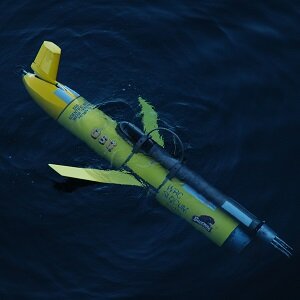
College of Engineering Unit:
Overall Project
This project is one of three OSU capstone projects this year working to obtain wave spectra data from a surfaced Slocum Glider. The overall combined goal of the teams is to obtain wave spectra, the distribution of the water’s energy as a function of frequency, from an ocean-borne glider. By assuming that the glider rode with the surface of the waves, the other two teams created a hardware and software package that allows us to read directional and non-directional wave spectra data from the glider, both during and after a mission. So go check them out too.
This Project
However, it is not true that the glider will always ride the waves. So, we need some way to tell for which frequencies the glider is riding the wave. To this end, it is useful to find the responses of the glider when subject to waves of a given period. When the RAO (the absolute value of the response) in the heave direction is approximately one, we know that the glider is indeed riding the waves and that we can get valid wave spectra data for those frequencies.
It just so happens that calculating the responses of the glider for all six degrees of freedom (surge, sway, heave, roll, pitch, yaw) is just as complex as finding only the heave. Similarly, it is easy to find the responses from waves of any given direction. Also, since the shape and mass distribution of the glider can change mission-to-mission, the project ended up being much more general. This application finds the six responses of a floating body subject to waves of given directions and periods and unit amplitude.
Method
I calculated the responses by solving a system of damped and coupled harmonic oscillators when subjected to external forces following the model provided by A. Alvarez in "Assessment of Sea Wave Spectra Using a Surfaced Glider" [1]. First, the user designs a model of the floating body's shape and mass distribution as an STL file and a list of point masses respectively. Now the application orientates the object to its neutral buoyancy position. Then, the app estimates the object's underwater surface with discrete triangles. Next, it calculates the radiation potential of each triangle by solving a system of equations of surface integrals. The surface integrals are then estimated using a Gaussian Quadrature and integrate either a Green function or its normal derivative, both of which are solved using Adaptive Simpson's method. Finally, the responses are the results of a system of equations of four matrices defined using the object’s shape, mass distribution, and radiation potentials.
Note
In his paper, Alvarez assumes that the water is inviscid to solve for the responses. However, he notes that the viscosity of the water is significant in the roll and yaw responses, leaving them incomplete [1].
Attachments
Installation And Workflow.pdf --- Contains a list of the required software, installation instructions, and an example workflow of what can be done and how.
Handoff Report.pdf --- Contains a User Guide that lists the major features of the app, a System Description that gives an overview of how the files interact, and a Development Software section about which software I used and how. Finally, Project Continuance is about upgrades that can be made to the app and how to go about implementing them.
Citation
[1] A. Alvarez, “Assessment of Sea Wave Spectra using a surfaced glider,” Deep Sea Research Part I: Oceanographic Research Papers, vol. 102, pp. 135–143, 2015. [Online]. Available: https://openlibrary.cmre.nato.int/bitstream/handle/20.500.12489/844/CMRE-PR-2019-104.pdf?sequence=1&isAllowed=y
Project Website(s):
Industry Sponsor(s):
Project Communication Piece(s):
| Attachment | Size |
|---|---|
| 155.26 KB | |
| 140.49 KB |